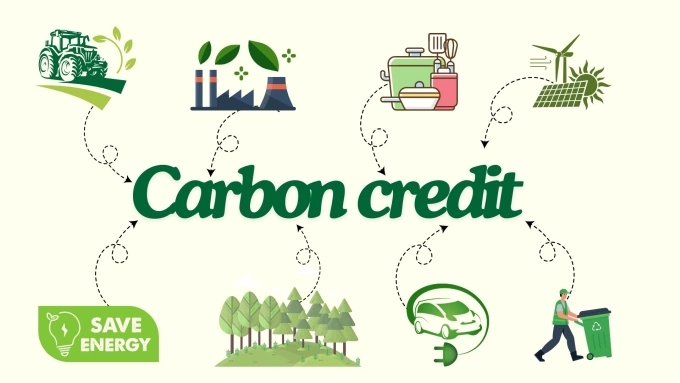Carbon Credits have emerged as a powerful tool in the global transition toward sustainable development and a low-carbon economy. In Vietnam, where economic growth and environmental protection must go hand in hand, the concept of Carbon Credits is gaining increasing attention. But for Vietnamese businesses, the question remains: are Carbon Credits a true driver of progress—or do they represent yet another challenge in an already competitive environment?
What Are Carbon Credits?
Carbon Credits are permits that allow the holder to emit a certain amount of carbon dioxide or other greenhouse gases. One Carbon Credit typically equals one ton of CO₂. These credits can be bought and sold on carbon markets, allowing companies to offset their emissions by supporting emission-reduction projects elsewhere.
Vietnam is part of several international agreements and frameworks focused on climate change, including the Paris Agreement. As such, the country is under increasing pressure to reduce emissions and promote low-carbon development. For businesses, this opens the door to participating in the Carbon Credits market—either to offset their own emissions or to generate new revenue through sustainable projects.

Understanding Carbon Credits: A Global Mechanism for Local Impact
Carbon Credits are tradable certificates that represent the right to emit one ton of carbon dioxide (CO2) or an equivalent greenhouse gas. These credits are part of global efforts to limit greenhouse gas emissions through carbon trading markets. By assigning a cost to carbon emissions, Carbon Credits create financial incentives for companies to reduce their environmental impact.
In Vietnam, Carbon Credits are not just a regulatory issue but a strategic one. Enterprises that manage to reduce emissions below the permitted limit can sell the surplus credits in both voluntary and compliance markets, thus creating an additional revenue stream.
Motivation for Development: Green Growth and Competitive Advantage
Vietnam’s commitment to achieving net-zero emissions by 2050, as declared at COP26, has created momentum for transforming business models toward sustainability. For many Vietnamese enterprises, Carbon Credits serve as a development motivation in several ways:
1. Encouraging Investment in Green Technologies
The potential for trading Carbon Credits encourages enterprises to invest in renewable energy, energy efficiency, waste treatment, and sustainable agriculture. These investments not only contribute to emission reductions but also improve productivity and long-term competitiveness.
2. Creating New Revenue Streams
Projects such as reforestation, biomass energy, and methane capture can generate a significant amount of Carbon Credits. Enterprises can monetize these credits by selling them to international buyers, especially in the voluntary carbon market where demand is increasing rapidly.

3. Improving Corporate Image and Brand Value
In today’s market, consumers and investors are more environmentally conscious. Businesses that actively participate in carbon reduction and trade Carbon Credits are perceived as responsible and forward-thinking, which helps attract customers, partners, and investment capital.
4. Accessing Green Finance and International Cooperation
Engagement in the Carbon Credits market can be a passport for Vietnamese enterprises to participate in global carbon funds, climate finance, and development programs. It also facilitates partnerships with multinational corporations that are subject to strict environmental standards.
Challenges for Vietnamese Enterprises
Despite the potential benefits, many Vietnamese businesses face significant hurdles in participating in the Carbon Credits market. These challenges stem from structural, technical, and policy-related factors.
1. Limited Awareness and Expertise
Many enterprises in Vietnam still lack understanding about how the Carbon Credits mechanism works. They are unaware of how to calculate emissions, develop carbon credit projects, or access trading platforms.

2. High Initial Investment
Implementing emission-reducing solutions often requires substantial capital investment, which is a major barrier for small and medium-sized enterprises (SMEs). Without support from government or financial institutions, many businesses cannot afford the upfront costs.
3. Complex and Costly Certification Process
To issue Carbon Credits, projects must undergo validation, monitoring, verification, and registration under recognized standards (such as Verra, Gold Standard, or CDM). These processes are time-consuming and costly, requiring technical expertise and legal support.
4. Unclear Policy Framework
Although Vietnam has shown commitment to developing the carbon market, the legal and regulatory framework remains incomplete. The lack of clear guidelines, incentives, and coordination among ministries creates uncertainty for enterprises considering carbon projects.
Government Efforts and the Way Forward
Recognizing the importance of Carbon Credits, the Vietnamese government has included carbon pricing and market development in the Law on Environmental Protection (2020). The Ministry of Natural Resources and Environment (MONRE) is developing a pilot carbon credit exchange platform and supporting frameworks to regulate domestic and international trading.
Vietnam is also cooperating with international organizations like the World Bank, UNDP, and bilateral partners to build capacity for carbon market readiness. These efforts aim to create a favorable environment for Vietnamese enterprises to participate more actively and effectively.

Strategic Recommendations for Vietnamese Enterprises
To turn Carbon Credits from a challenge into a development motivation, Vietnamese businesses should consider the following steps:
-
Enhance Knowledge and Capacity: Invest in training and consultation on carbon accounting, MRV (Monitoring, Reporting, and Verification), and project development.
-
Collaborate with Experts: Work with certified consultants and carbon market intermediaries to ensure project quality and maximize returns.
-
Leverage Digital Tools: Utilize digital platforms and carbon management software to streamline data collection, emission calculation, and credit tracking.
-
Engage in Policy Dialogue: Participate in industry associations and forums to voice concerns, contribute to policy development, and stay informed about legal updates.
-
Seek Green Finance: Approach banks, investment funds, and development agencies that offer loans or grants for climate-related projects.
Conclusion
Carbon Credits can be both a powerful motivator and a significant challenge for Vietnamese enterprises. The extent to which they benefit from this mechanism depends on their readiness to transform and adapt. With the right support, knowledge, and strategy, Carbon Credits can drive innovation, profitability, and sustainable growth for businesses across Vietnam.
As Vietnam moves towards a low-carbon economy, the ability of its enterprises to embrace Carbon Credits will be crucial. Rather than seeing them as a burden, visionary businesses should recognize Carbon Credits as a gateway to the future of green development.
